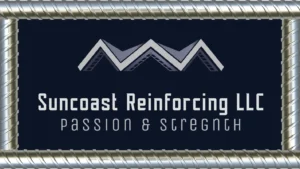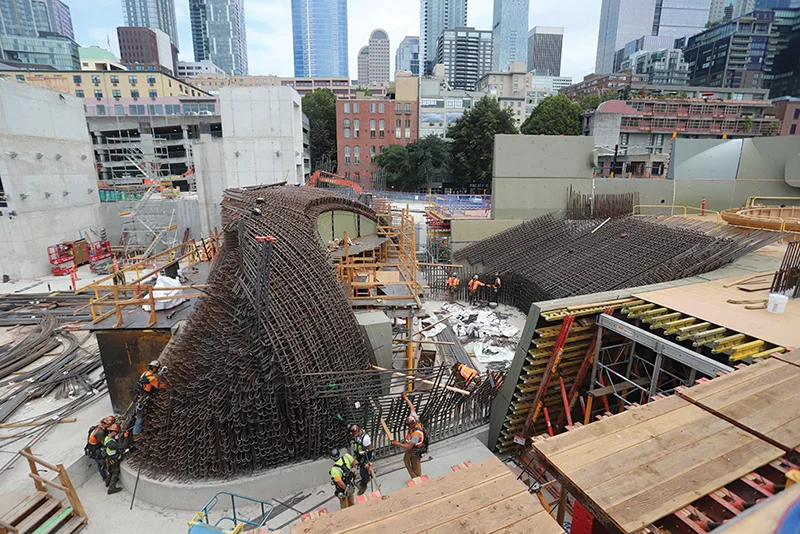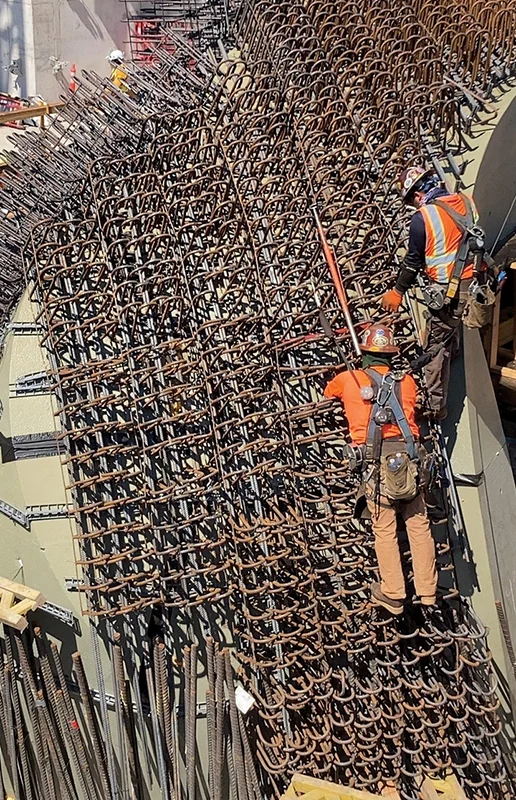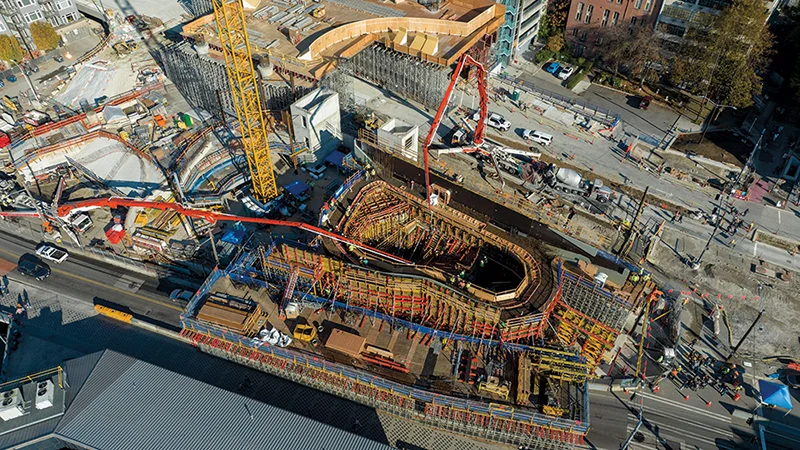From the ENRNorthwest (story and photos) — By Nadine M. Post
The 50,000-sq-ft Ocean Pavilion is the centerpiece of Waterfront Seattle, the infrastructure makeover of the Puget Sound waterfront
Patrick Nation describes the reinforcing steel for the main tank of the 50,000-sq-ft Seattle Aquarium Ocean Pavilion as a “monster” job for CMC Rebar. In his mind, it was like bending 496 tons of bars “on a golf ball.” In reality, the operation was more like weaving a giant steel basket. Ironworkers had to painstakingly hand-thread the reinforcing steel for the doubly curved and slanted concrete walls of the 350,000-gallon saltwater exhibit—one bar at a time—to create the dense latticework for the 41-ft-tall basket.
The work on the Coral Canyon tank was way “outside the box” of CMC’s experience, says Nation, the rebar fabricator-erector’s operations manager. But that didn’t faze him.
“I was jazzed from the start,” he adds. Still, Nation says “holy moly” was the mild expletive he uttered when he first saw the concept design for the tank, because nearly every bar had to be bent on a prescribed radius.
The 2-ft-thick Coral Canyon walls, with six layers of reinforcement, have more than three times the quantity of rebar per cu yd of concrete than there is in the typical core of a high-rise in earthquake-prone Seattle, according to Turner Construction Co., the general contractor that self-performed concrete work.
The latticework of bars—mostly but not all prebent and no two alike or set at the same orientation in space—was so intimidating that Turner created a 3D digital rebar model to describe and locate every single bar. And the rebar was so dense that, to get around the bars, the concrete mix, pumped into the wall formwork, not only had to be self-consolidating, it had to have a grout-like consistency free of aggregate.
Nation isn’t the only construction veteran boggled by the project. Coral Canyon was “the most complicated concrete construction we had done to date,” says Bryce McDowell, Turner’s self-perform operations manager.
That was at least until early this year, four months after the tank was cast, when Turner built the Ocean Pavilion’s 27,600-gallon Archipelago. The complex coordinate geometry of the exhibit—three amorphous, conjoined concrete tanks—made the Archipelago “possibly even more challenging” than the bigger tank, says McDowell. Turner used shotcrete for the Archipelago.
Across the street from the existing aquarium on piers 59 and 60, the two-level Ocean Pavilion, designed by LMN Architects with a rooftop public park, sits on a 38,000-sq-ft strip of city land in the old Alaskan Way right of way. Though a separate development, the pavilion is viewed as the $160-million centerpiece of the city’s $1-billion-plus remake of the Puget Sound waterfront. Called Waterfront Seattle, the multiyear infrastructure project is set to wrap up in 2025. It is a response to the removal of the double-decker Alaskan Way Viaduct, which carried State Route 99 until the opening in February 2019 of the SR 99 tunnel.
Set for substantial completion this February, the Ocean Pavilion has been a brainteaser. Construction veteran Stuart Kibbee has decommissioned a nuclear power plant. Still, he says he never has had as demanding a job. “There is nothing normal or easy about this,” says Kibbee, Turner’s construction executive. “If we were going to build it in a corn field in Iowa, this building would be difficult,” he adds. But the urban waterfront setting, on a fill site in a seismic zone, made constructing the zero-lot-line building beyond difficult. “I don’t think any of us knew just how complicated this was” going to be, says Kibbee.
The expansion is in the “absolutely right” location for visitors because it is near the existing aquarium, says Jay Taylor, senior principal-retired for structural engineer Magnusson Klemencic Associates (MKA), which also is the pavilion’s civil engineer. However, highly liquefiable soils, contaminants and undocumented subterranean timber remnants of a centuries-old waterfront pier structure make it the “absolutely wrong location” to build a highly settlement-sensitive 350,000-gallon-capacity tank, he adds.
“It would be hard to find a worse site,” says Taylor, a veteran designer of out-of-the-box structures on impossible sites, including the recently opened Perelman Performing Arts Center at New York’s World Trade Center.
The 50-ft-tall Ocean Pavilion is shoehorned into a right of way with no staging or laydown space. To make matters worse, there are two concurrent Waterfront Seattle projects that touch the aquarium site—the realignment of the north-south Alaskan Way from the west side to the east side of the pavilion and the Overlook Walk pedestrian bridge over the realigned Alaskan Way that connects the landmark Pike Place Market—on the hilltop—to the waterfront.
Three jobs with intertwined fates meant lots of coordination and even some cooperation. At times during construction, the Overlook Walk shoring went through the Ocean Pavilion structure and was supported by the Ocean Pavilion’s mat foundation.
“We knew there would be some challenges in construction,” says Susan Bullerdick, director of capital projects for the Seattle Aquarium, operator of the city-owned aquarium, owner of the exhibits and developer of the Ocean Pavilion. “We didn’t go in naively.”
But no one could have predicted COVID-19, materials and fuel cost escalation and a five-month concrete strike beginning in December 2021.
“We were coming off of COVID and got hit by a concrete strike,” says Angela Brady, Seattle’s director of the office of the waterfront and civic projects. The strike caused delays and funding problems for the Alaskan Way realignment project, she says.
The roadway delay affected the pavilion schedule. Turner had planned to use the vacated strip along the pavilion’s west side to support the main tank’s west wall.
Instead, Turner had to stop work, regroup and build an over-the-road protection platform, which doubled as support for and a staging area for the tank. That not only cost $1 million, it delayed the pavilion by a year. That is one of the reasons Turner’s guaranteed maximum price increased to $113 million from $98 million, says Kibbee.
Construction of the pavilion should be done by the spring. The opening is set for the summer. “It’s amazing, given the [circumstances] that we could keep going,” says Bullerdick, adding that the aquarium itself shut down for 206 days during the pandemic.
To tame the construction beast, the design team and Turner—and even Turner’s subs—brainstormed during the design phase to cut costs and improve formwork and rebar fabrication and constructibility. Though the contractual obligations are conventional, in terms of team behavior, the project resembles progressive design-build, says Kibbee. Hannah A. Bonotto, MKA’s senior design engineer, describes the behaviors as integrated project delivery-like, especially through the design and detailing phases.
“The coordination and construction of the main tank could only have been done with a trusted design partner in Turner,” says Bonotto, noting that Turner and MKA have worked together on jobs for 50 years.
At the center of the collaboration is LMN’s 3D parametric design model. Kibbee says LMN’s model for the main tank was provided as a contract document, with the 2D drawings. Turner used the model directly as the basis for its construction BIM, rather than building the BIM from scratch using the 2D drawings, as it typically does.
During value engineering, LMN and Turner eliminated the basement, which would have been below the water table, saving more than $3 million. Instead, LMN tucked the sea creatures’ life support systems under the plaza of Overlook Walk, immediately to the north.
LMN also reconceived the rooftop park and Overlook Walk as one seamless walkway that culminates at the waterfront. “We developed a design with Overlook Walk architect Miller Hull where the line is blurred between the two projects,” says Mark Reddington, an LMN partner.
It helps that both have the same landscape architect, James Corner Field Operations, and civil engineer, MKA.
That allowed another simplification. MKA’s original concept for the foundation was a mat supported by deep auger-cast piles. Based on feedback from the foundation subcontractor, Turner suggested a mat that instead spans to less costly deep-soil-mixed columns. The mat surface doubles as the building’s ground floor.
In another coup, this time to cut the cost of the formwork for the main tank, LMN introduced Turner to Janicki Industries, a fabricator north of Seattle that makes parts, tools and molds for airplanes, boats, wind turbines and other odd shapes. “We had been talking to Janicki for almost 10 years about how to bring their tool and processes into construction,” says Scott Crawford, an LMN partner. “They ended up using our 3D digital model to fabricate all of the [foam panels] for the Coral Canyon and [that] saved a bunch of money,” he adds.
Other MKA-Turner conversations resulted in two key changes to make the rebar more constructible. At Turner’s and CMC’s suggestion, the main tank rebar went from larger-diameter #9 and #11 bars—nearly impossible to bend in the field to meet the varied curvature of the tank—to smaller, more easily bendable #6 bars—two #6s for the #9 bars and three for the #11 bars. MKA also allowed the rebar installation to be tilted in any orientation provided that, in the rebar grid, the mostly vertical bars remained perpendicular to their cross bars.
PHOTO CAPTIONS: The single toughest nut to crack on the project may have been the reinforcing steel installation for the curved and sloped walls of the main tank. Ironworkers created a latticework of steel mesh by weaving in each bent bar by hand, painstakingly following a placing drawing that prescribed the exact of location of each bar. There were no two bars alike.
Credits: Photo top: Courtesy of Turner Construction
Photo Below-Left: Courtesy of CMC
Suncoast Reinforcing is hiring!
If you’re looking for work, contact Suncoast Reinforcement for information about current openings.
We’re nearly always hiring skilled ironworkers, supervisors and helpers.





0 Comments